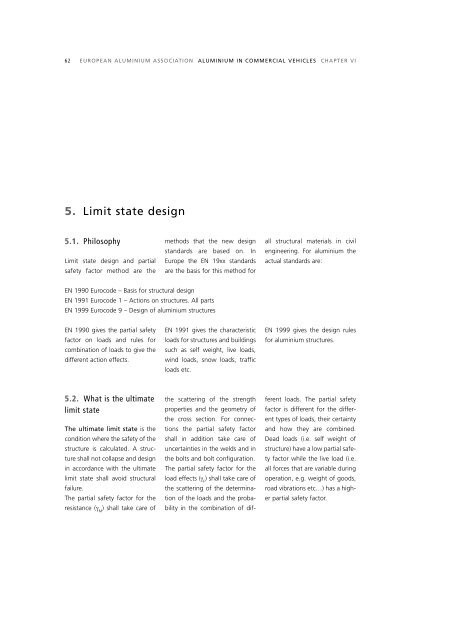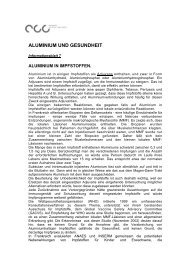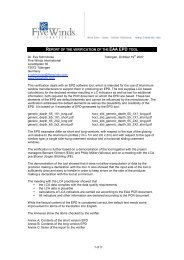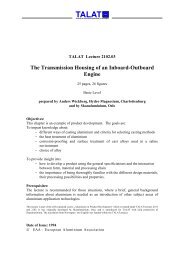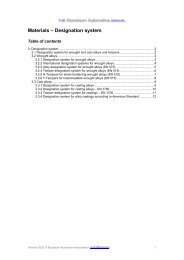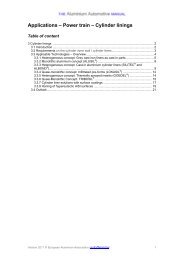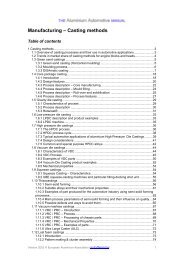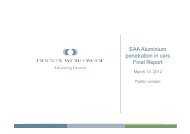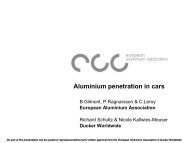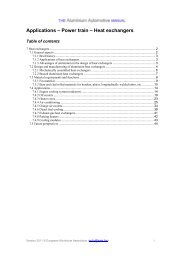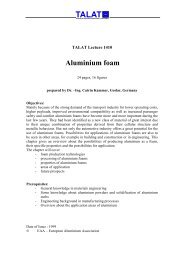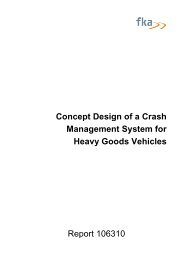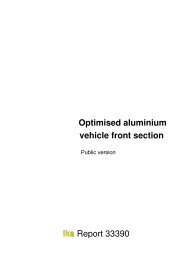aluminium in commercial vehicles - European Aluminium Association
aluminium in commercial vehicles - European Aluminium Association
aluminium in commercial vehicles - European Aluminium Association
You also want an ePaper? Increase the reach of your titles
YUMPU automatically turns print PDFs into web optimized ePapers that Google loves.
62 EUROPEAN ALUMINIUM ASSOCIATION ALUMINIUM IN COMMERCIAL VEHICLES CHAPTER VI<br />
5. Limit state design<br />
5.1. Philosophy<br />
Limit state design and partial<br />
safety factor method are the<br />
methods that the new design<br />
standards are based on. In<br />
Europe the EN 19xx standards<br />
are the basis for this method for<br />
EN 1990 Eurocode – Basis for structural design<br />
EN 1991 Eurocode 1 – Actions on structures. All parts<br />
EN 1999 Eurocode 9 – Design of <strong>alum<strong>in</strong>ium</strong> structures<br />
EN 1990 gives the partial safety<br />
factor on loads and rules for<br />
comb<strong>in</strong>ation of loads to give the<br />
different action effects.<br />
5.2. What is the ultimate<br />
limit state<br />
The ultimate limit state is the<br />
condition where the safety of the<br />
structure is calculated. A structure<br />
shall not collapse and design<br />
<strong>in</strong> accordance with the ultimate<br />
limit state shall avoid structural<br />
failure.<br />
The partial safety factor for the<br />
resistance (γ ) shall take care of<br />
M<br />
EN 1991 gives the characteristic<br />
loads for structures and build<strong>in</strong>gs<br />
such as self weight, live loads,<br />
w<strong>in</strong>d loads, snow loads, traffic<br />
loads etc.<br />
the scatter<strong>in</strong>g of the strength<br />
properties and the geometry of<br />
the cross section. For connections<br />
the partial safety factor<br />
shall <strong>in</strong> addition take care of<br />
uncerta<strong>in</strong>ties <strong>in</strong> the welds and <strong>in</strong><br />
the bolts and bolt configuration.<br />
The partial safety factor for the<br />
load effects (γ ) shall take care of<br />
F<br />
the scatter<strong>in</strong>g of the determ<strong>in</strong>ation<br />
of the loads and the probability<br />
<strong>in</strong> the comb<strong>in</strong>ation of dif-<br />
all structural materials <strong>in</strong> civil<br />
eng<strong>in</strong>eer<strong>in</strong>g. For <strong>alum<strong>in</strong>ium</strong> the<br />
actual standards are:<br />
EN 1999 gives the design rules<br />
for <strong>alum<strong>in</strong>ium</strong> structures.<br />
ferent loads. The partial safety<br />
factor is different for the different<br />
types of loads, their certa<strong>in</strong>ty<br />
and how they are comb<strong>in</strong>ed.<br />
Dead loads (i.e. self weight of<br />
structure) have a low partial safety<br />
factor while the live load (i.e.<br />
all forces that are variable dur<strong>in</strong>g<br />
operation, e.g. weight of goods,<br />
road vibrations etc…) has a higher<br />
partial safety factor.


